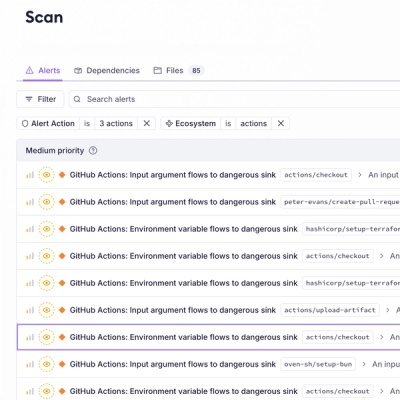
Product
Introducing Socket Firewall Enterprise: Flexible, Configurable Protection for Modern Package Ecosystems
Socket Firewall Enterprise is now available with flexible deployment, configurable policies, and expanded language support.
@bitovi/scrolling-nav
Advanced tools
Just drop it in to enable quick navigation to sections of your page.
A web component for navigating to sections of your page that can stick as you scroll.
If you are using a module loader, you can install the web component with NPM like:
npm install @bitovi/scrolling-nav
Import the web component:
import "../../node_modules/@bitovi/scrolling-nav";
To use, just insert the HTML element tag created by the package.
<scrolling-nav></scrolling-nav>
That's it.
You can optionally provide attributes to the component to customize your experience. Here are the default attribute values.
<scrolling-nav
scrollable-container-selector="window"
heading-selector="h2"
></scrolling-nav>
falsestring"window"The scrollable-container-selector attribute is the tag (HTML element, class, or ID) contains the section headings that you want to scroll to. By default, it will be the window.
<scrolling-nav scrollable-container-selector=".header"></scrolling-nav>
falsestring"h2"The heading-selector attribute is the tag (HTML element, class, or ID) that will be used to create the navbar items. By default, it will scour the <body> for H2 tags.
<scrolling-nav heading-selector="h3"><scrolling-nav>
You can override or modify the default styles by using the provided IDs and classes. The component is structured like the following:
<scrolling-nav>
<ul class="scrolling-nav-inner">
...
<ul class="scrolling-nav-item">
<a>Heading Example 1</a>
</ul>
...
<ul class="scrolling-nav-item">
<a>Heading Example 2</a>
</ul>
...
</div>
</scrolling-nav>
To customize the styles of the navbar container, use the following tag in your styles:
scrolling-nav {}
To customize the styles of the navbar inner container (which is scrolled by the outer container), use the following ID in your styles:
scrolling-nav > ul {}
To customize the styles of the navbar's items, use the following class in your styles:
scrolling-nav > ul > li {}
If you want to customize the active state of a nav item, use the following class in your styles:
scrolling-nav > ul > li.scrolling-nav-active {}
The scrolling-nav-active class is added whenever the section represented by the nav item is in or below the top 1/3 of the page and above of the next section in the page. The scrolling-nav-active class will only be applied to one item at a time.
You may get the following linting error on the web component: Property 'scrolling-nav' does not exist on type 'JSX.IntrinsicElements'. To fix this, add the following snippet to your declarations.d.ts file.
// In ~/declarations.d.ts
declare namespace JSX {
// ...
interface IntrinsicElements {
// ...
"scrolling-nav": any;
}
}
FAQs
Did you know?

Socket for GitHub automatically highlights issues in each pull request and monitors the health of all your open source dependencies. Discover the contents of your packages and block harmful activity before you install or update your dependencies.

Product
Socket Firewall Enterprise is now available with flexible deployment, configurable policies, and expanded language support.

Security News
Open source dashboard CNAPulse tracks CVE Numbering Authorities’ publishing activity, highlighting trends and transparency across the CVE ecosystem.

Product
Detect malware, unsafe data flows, and license issues in GitHub Actions with Socket’s new workflow scanning support.